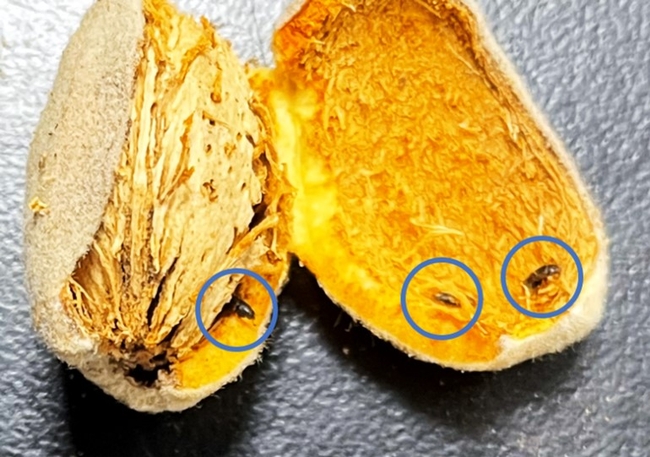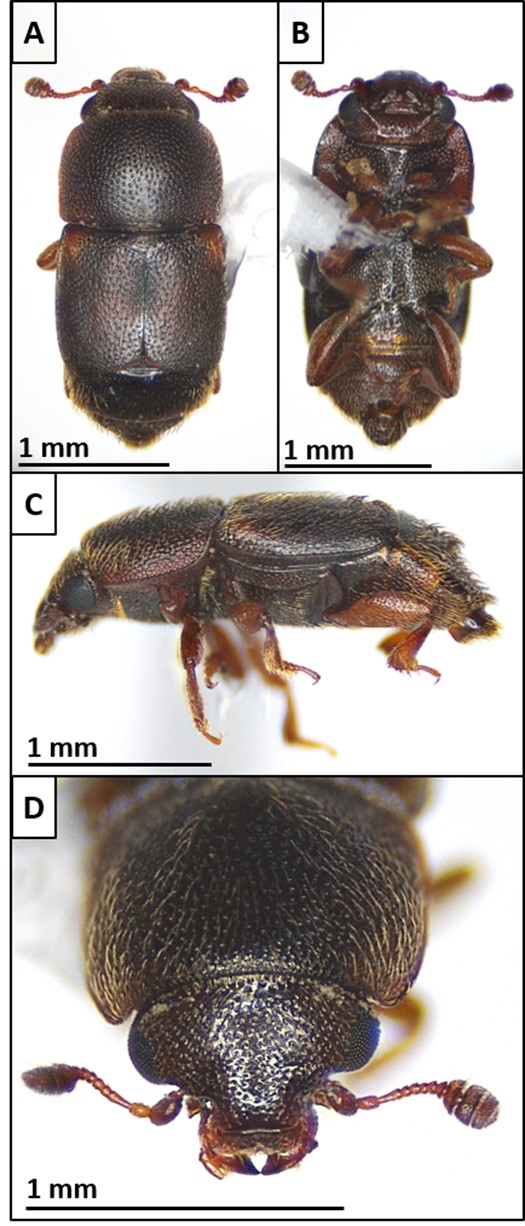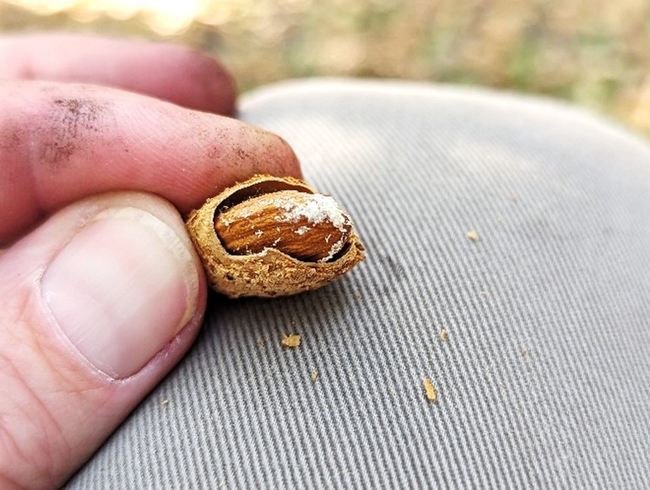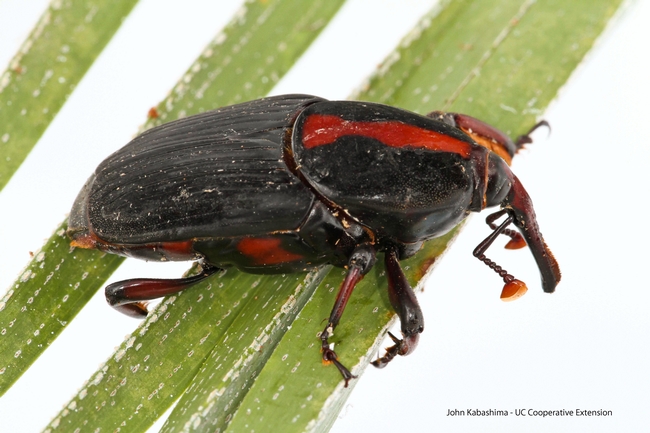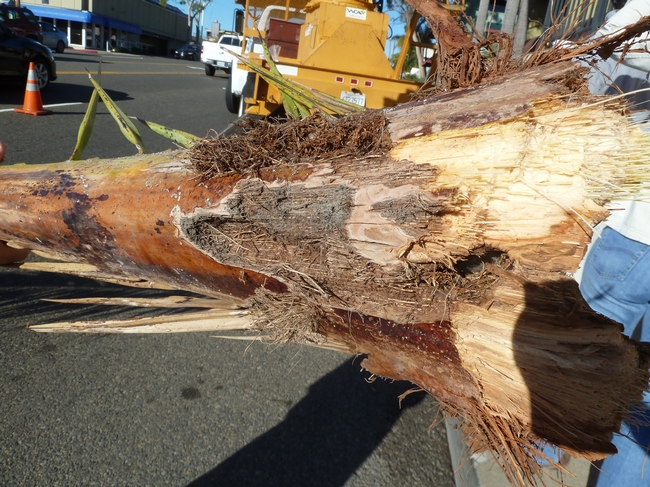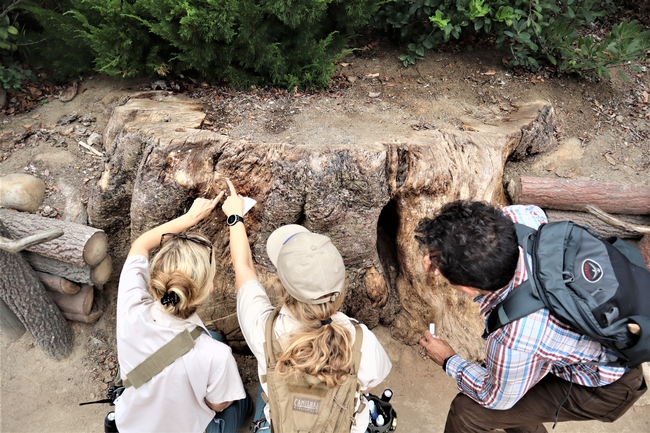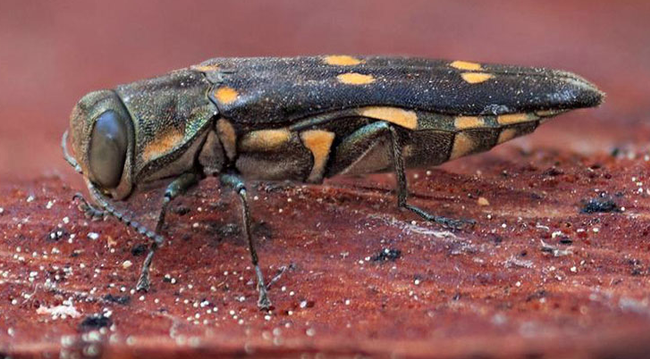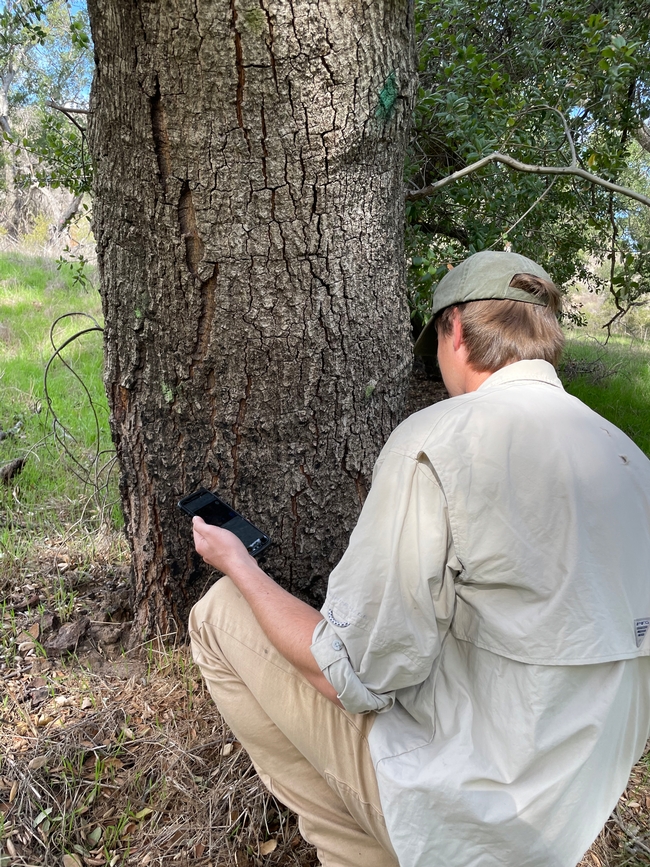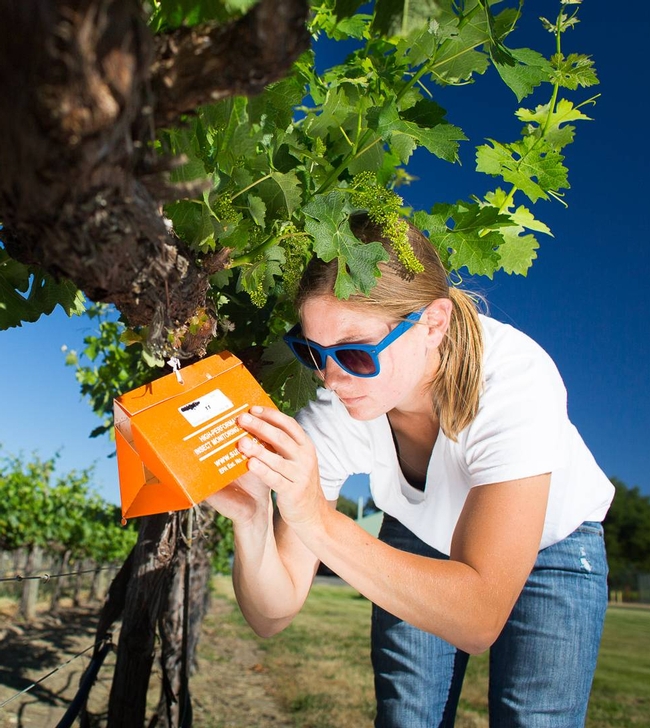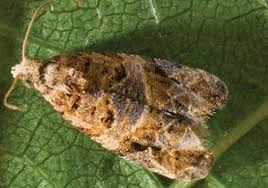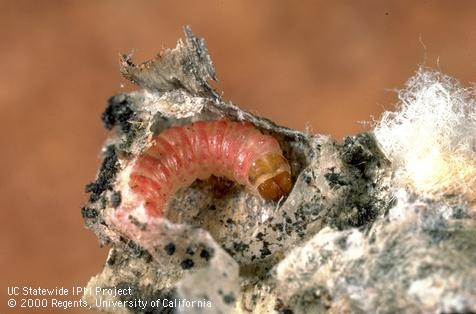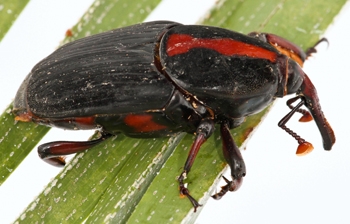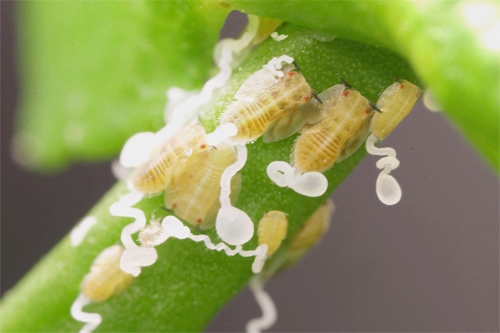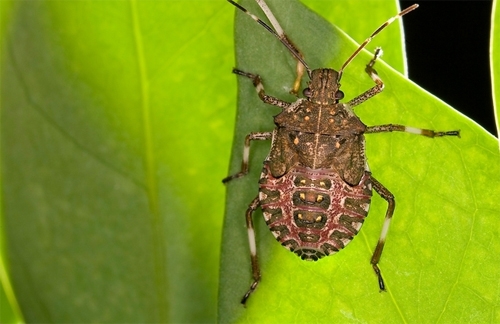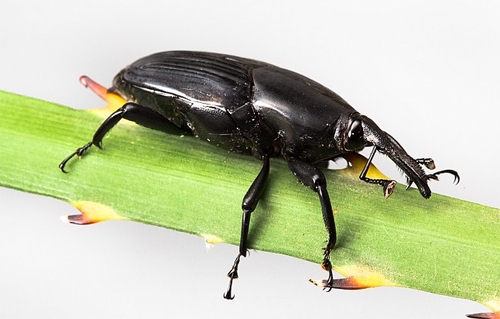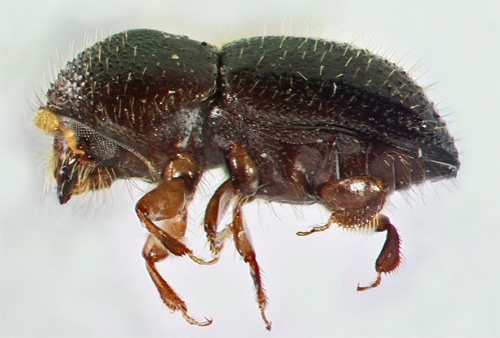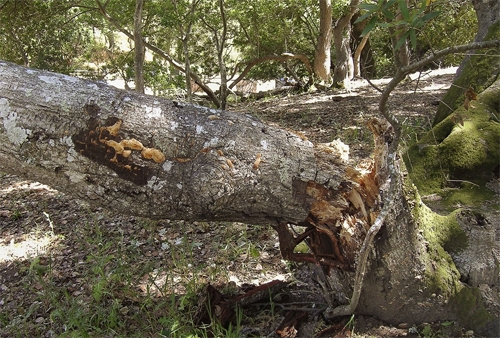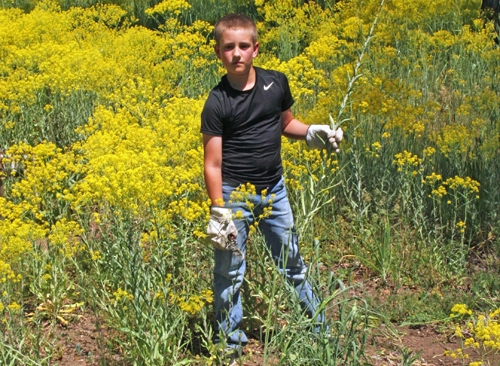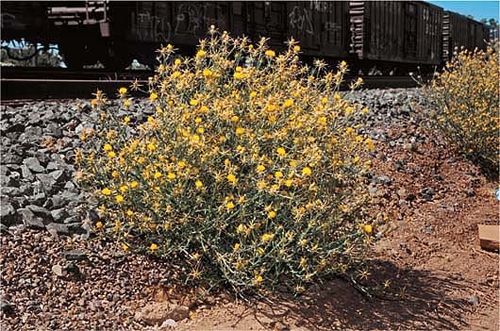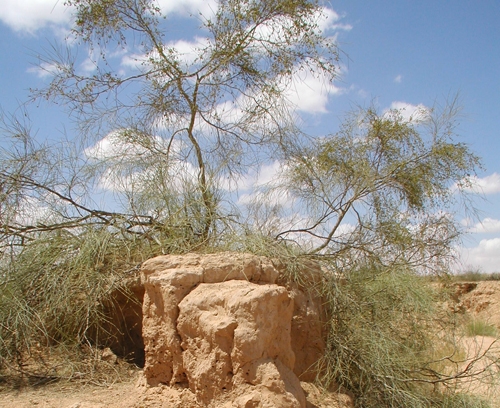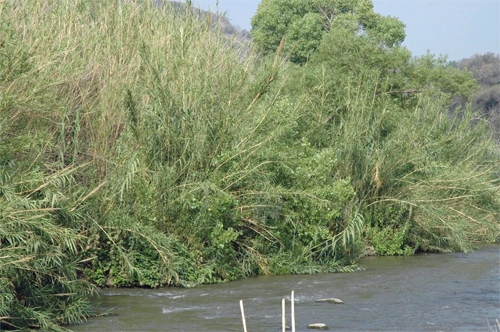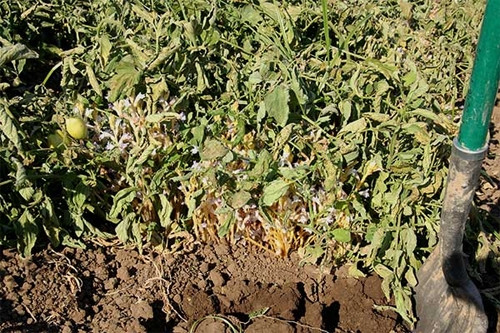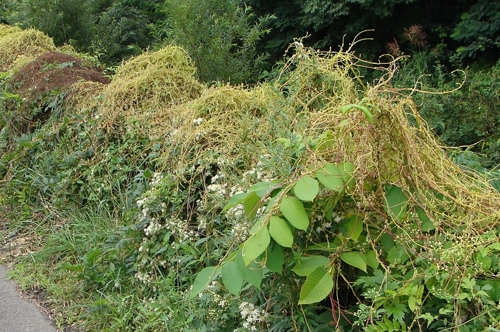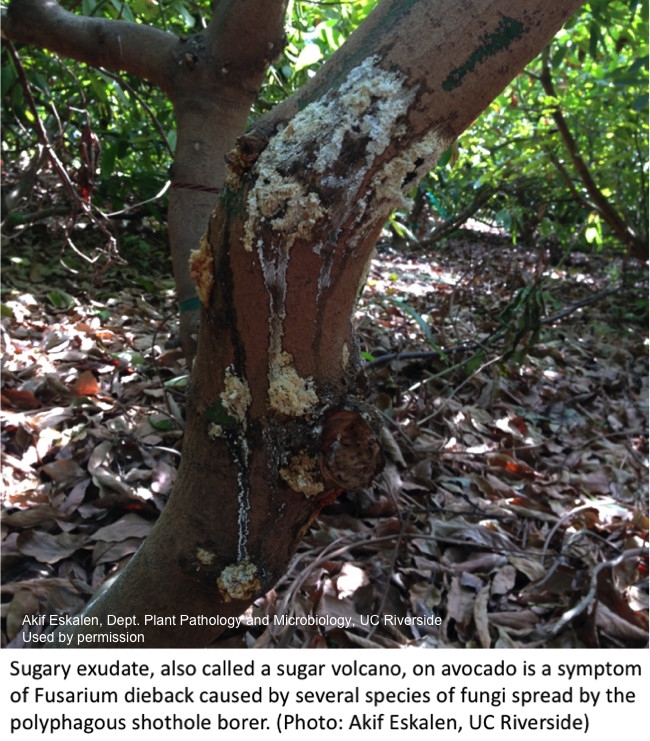Posts Tagged: Invasive
New pest infesting almonds and pistachios in the San Joaquin Valley
Crop sanitation will be key to controlling the invasive carpophilus beetle
Growers and pest control advisers (PCAs) should be on the lookout for a new pest called carpophilus beetle (Carpophilus truncatus). This pest was recently found infesting almonds and pistachios in the San Joaquin Valley, and is recognized as one of the top two pests of almond production in Australia. Damage occurs when adults and larvae feed directly on the kernel, causing reductions in both yield and quality.
Populations of carpophilus beetle were first detected in September in almond and pistachio orchards by University of California Cooperative Extension Specialist Houston Wilson of UC Riverside's Department of Entomology. Pest identification was subsequently confirmed by the California Department of Food and Agriculture.
Wilson is now working with Jhalendra Rijal, UC integrated pest management advisor, North San Joaquin Valley; David Haviland, UCCE farm advisor, Kern County; and other UCCE farm advisors to conduct a broader survey of orchards throughout the San Joaquin Valley to determine the extent of the outbreak.
To date, almond or pistachio orchards infested by carpophilus beetle have been confirmed in Stanislaus, Merced, Madera and Kings counties, suggesting that the establishment of this new pest is already widespread. In fact, some specimens from Merced County were from collections that were made in 2022, suggesting that the pest has been present in the San Joaquin Valley for at least a year already.
“It has likely been here for a few years based on the damage we've seen," Rijal said.
This invasive beetle overwinters in remnant nuts (i.e. mummy nuts) that are left in the tree or on the ground following the previous year's harvest. Adults move onto new crop nuts around hull-split, where they deposit their eggs directly onto the nut. The larvae that emerge feed on the developing kernels, leaving the almond kernel packed with a fine powdery mix of nutmeat and frass that is sometimes accompanied by an oval-shaped tunnel.
Carpophilus beetle has been well-established in Australia for over 10 years, where it is considered a key pest of almonds. More recently, the beetle was reported from walnuts in Argentina and Italy as well. Carpophilus truncatus is a close relative to other beetles in the genus Carpophilus, such as the driedfruit beetle (C. hemipterus) that is known primarily as a postharvest pest of figs and raisins in California.
Monitoring for carpophilus beetle is currently limited to direct inspection of hull split nuts for the presence of feeding holes and/or larvae or adult beetles. A new pheromone lure that is being developed in Australia may soon provide a better monitoring tool for growers, PCAs and researchers.
“We're lucky to have colleagues abroad that have already been hammering away at this pest for almost a decade,” said Haviland. “Hopefully we can learn from their experiences and quickly get this new beetle under control.”
The ability to use insecticides to control carpophilus beetle remains unclear. The majority of the beetle's life cycle is spent protected inside the nut, with relatively short windows of opportunity available to attack the adults while they are exposed. The location of the beetles within the nut throughout most of their life cycle also allows them to avoid meaningful levels of biological control.
In the absence of clear chemical or biological control strategies, the most important tool for managing this beetle is crop sanitation.
“Given that this pest overwinters on remnant nuts, similar to navel orangeworm, crop sanitation will be fundamental to controlling it,” Wilson said. “If you needed another reason to clean up and destroy mummy nuts – this is it.”
In Australia, sanitation is currently the primary method for managing this pest. And here in California, new research and extension activities focused on carpophilus beetle are currently in the works.
“It's important that we get on top of this immediately,” said Wilson. “We're already starting to put together a game plan for research and extension in 2024 and beyond.”
If you suspect that you have this beetle in your orchard, please contact your local UC Cooperative Extension farm advisor (https://ucanr.edu/About/Locations/), County Agricultural Commissioner (https://cacasa.org/county/) and/or the CDFA Pest Hotline (https://www.cdfa.ca.gov/plant/reportapest/) at 1-800-491-1899.
Invasive pests kill thousands of trees, but scientists see some successes
Early detection increases the chances of eradicating pests
Trees provide shade to keep us cool, produce oxygen for us to breathe and calm our nerves. Numerous studies have demonstrated that even brief contact with trees and green spaces can provide significant human health benefits such as reductions in blood pressure and stress-related hormones. Trees also reduce noise and visual pollution, help manage storm water runoff, reduce erosion and provide habitat for birds and wildlife. Trees naturally capture carbon, helping to offset the forces of climate change. They also increase the value of our properties and communities. In short, trees are essential to our well-being.
Unfortunately, invasive pests pose an ongoing threat to California's forests in both urban and wildland settings. Invasive insects such as goldspotted oak borer and invasive shothole borers have killed hundreds of thousands of trees in Southern California and are continuing to spread. Meanwhile, other pests and diseases such as Mediterranean oak borer and sudden oak death are killing trees in Northern California.
While the situation may sound dire, it is not hopeless. Of course, the best way to stop invasive pests is to prevent them from entering the state, as the California Department of Food and Agriculture has done on many occasions. For example, several months ago, CDFA border inspectors seized a load of firewood containing spotted lanternfly eggs (a pest that is causing extensive damage on the East Coast). When pests do sneak in, the next defense is to catch them early before they become established. Finally, even if pests do become established, they can be managed if not completely eradicated.
A few examples may help to illustrate why invasive tree pests deserve action, but not panic.
Red striped palm weevil eradicated in Laguna Beach
When red striped palm weevil, a highly destructive palm pest native to Indonesia, was discovered in Laguna Beach in October 2010, a working group was quickly formed to develop a management plan. The small but diverse group included international palm weevil experts, research scientists from University of California Riverside, CDFA and U.S. Department of Agriculture, UC Cooperative Extension personnel from San Diego, Orange and Los Angeles counties and county entomologists from the agricultural commissioner's offices in Orange and San Diego counties.
The resulting response included a pheromone-based trapping program, public advisory and targeted insecticide treatments. Within two years, additional trapping and inspections could not find any signs of continued infestations. Early detection was key to the success: the infestation in Laguna Beach was identified early, so the weevil population was still relatively small. In addition, Laguna Beach is geographically isolated, the local climate is much cooler than the weevil's place of origin, and the eradication effort was well funded by state and federal agencies. Eliminating invasive pests where such conditions are not present may prove more difficult.
Invasive shothole borers attack Disneyland
The Disneyland Resort in Anaheim contains 16,000 trees and over 680 different tree species. When park officials identified an infestation by invasive shothole borers in 2016, their initial attempts at vanquishing the insects with pesticides produced mixed results. Then, they consulted with experts from UC Riverside and UC Cooperative Extension and together designed and followed an integrated pest management program that included monthly ground surveys, a trapping program that helped to detect infestation hot spots and find and remove the source of beetles, and occasional pesticide treatments on selected trees. The park went from a large number of beetles in 2017 to very low levels today. There are still some beetles, but resulting damage is extremely low, and although monitoring programs continue, the park's landscape team has been able to turn its focus elsewhere.
Goldspotted oak borer spotted in Weir Canyon
When goldspotted oak borer was confirmed in Orange County's Weir Canyon in 2014, a team from Irvine Ranch Conservancy, the organization that manages the area on behalf of Orange County Parks, sprang into action. UC Cooperative Extension and the US Forest Service assisted IRC in developing a management program, and over the ensuing years, IRC has actively collaborated with OC Parks, The Nature Conservancy, OC Fire Authority, and CAL FIRE to control the existing infestation and stop its spread. IRC has surveyed the oaks in the area yearly to monitor the infestation and guide each year's management actions.
To reduce the spread of the infestation, IRC removed more than 100 severely infested oaks in the first few years of management (no severely infested oaks have been found in the last few years of surveys). Additionally, more than 3,000 tree trunks have been sprayed annually in the late spring to kill emerging adult beetles and newly hatched offspring.
In the most recent survey of the oaks in Weir Canyon, the IRC team found only 12 trees with new exit holes, and most of those had just one to two exit holes per tree, which is an extremely low number. With the situation well under control, IRC is now considering modifying its annual spraying program and adapting other less aggressive treatment options. Finally, IRC has been actively planting acorns to mitigate losses due to the removals as well as the Canyon 2 Fire of 2016.
As these brief examples demonstrate, insect pest infestations can be managed or even eradicated if caught early enough. Early detection not only increases the chances of success, but also minimizes the cost of pest management efforts.
What you can do to prevent infestation
While management actions will vary depending on the insect or disease, species of tree and location, there are a few steps that will lead to greater success in fighting tree pests and diseases.
- Keep your trees healthy. Proper irrigation and maintenance go a long way toward keeping trees strong and resistant to pests and diseases.
- Check your trees early and often for signs and symptoms of tree pests and diseases. These may include entry/exit holes, staining, gumming, sugary build-ups, sawdust-like excretions, and branch or canopy dieback. Use available tools like the UC IPM website to determine probable causes of the problems.
- Talk with experts (arborists, pest control advisers, researchers and advisors from the University of California and other institutions), and report pest findings to your county Agricultural Commissioner.
- Evaluate the extent of tree damage and determine a management plan. Remove severely infested branches and trees that may be a source of insect pests that can attack other trees.
- Properly manage infested wood and green waste. Chip wood and other plant materials as small as possible. Solarization or composting can further increase the effectiveness of chipping. It is generally best to keep those materials close to where they originated, but if you absolutely need to move them, first make sure the facility where they will be sent is equipped to process them. Always tightly cover materials while in transit. If working with a tree care professional, insist that proper disposal is part of the job requirements.
- Many invasive tree pests can survive in down wood for long periods. When buying or collecting firewood, always obtain it as close as possible to where you are going to burn it and leave leftover firewood in place.
A team approach is key to conquering invasive species
At an invasive species summit last year in Sacramento, UC ANR vice president Glenda Humiston and California Department of Food and Agriculture secretary Karen Ross convened scientists, government representatives and volunteers to pool intellectual resources and plot a strategy for protecting agricultural crops, natural resources, cityscapes and residential neighborhoods from invasive species.
“We know that collectively, we have the tools and expertise to prevent invasive species from entering California, spreading and becoming established,” Humiston said.
Below are three examples of pests that entered California, and with research, collaboration and treatment, were eradicated from the state.
|
European grapevine moth European grapevine moth, a native of Mediterranean Europe, was detected for the first time in the Americas in Chile in April 2008. The following year, European grapevine moth was found in California's iconic wine region, Napa Valley. From there it spread to nine other California counties, as far south as Fresno. UC ANR academics responded rapidly — working with public and private partners and international scientists — to develop a pest management program that relied on deploying pheromone dispensers to disrupt mating and application of carefully timed insecticides. UC ANR academics studied the moth's biology, life cycle, host range and proven management practices. In short order, the moth population plummeted, and eventually the state was declared free of European grapevine moth, lifting a quarantine, enhancing farmers' ability to export their agricultural products, and preserving the communities' economic wellbeing. More info: Growers, scientists and regulators collaborate on European grapevine moth program
|
|
|
Pink bollworm of cotton It took 50 years, but the invasive pink bollworm of cotton was declared eradicated in California in 2018. Eradication of pink bollworm was a joint effort by UC Cooperative Extension, USDA's Agricultural Research Service, county agricultural commissioners' offices and California cotton growers. It involved the implementation of integrated pest management techniques, such as planting transgenic cotton, using insect pheromones to disrupt mating, releasing sterile insects to slow reproduction, plowing after each crop to provide host-free periods, and extensive surveying. California cotton growers funded the program by paying an assessment on cotton grown in the state. More info: Pink bollworm UC Pest Management Guidelines |
|
|
Red palm weevil In August 2010, arborists removed a dying Canary Island date palm from the yard of a Laguna Beach home and reported finding large black and red striped beetles. The pests were confirmed to be the first record of the destructive red palm weevil in the U.S. Hormone monitoring and visual surveys of other palms in the area confirmed the presence of the pest. Rapid action was taken against the pest by applying pesticides to trees that showed feeding damage to palm fronds. Effective surveying was accomplished by combining hormone attractants and cut pieces of palm trees provided by the California date palm industry. The last live weevil was detected in Laguna in January 2012. After three years passed with no weevil detections in Laguna Beach, USDA-APHIS declared this pest to be officially eradicated in January 2015. More info: Red palm weevil successfully eradicated form California |
Invasive species threaten California’s economy and ecology
When insects, weeds, animals and diseases enter California from elsewhere in the nation or world, they can cause economic losses to agricultural crops and ecological damage to the state's natural areas. Ultimately, invasive species affect every resident of California.
Based on historical data, a new invertebrate species establishes itself in California about every six weeks, on average. They don't all become serious pest problems, but many evade eradication efforts, disrupt carefully balanced integrated pest management programs, hijack sensitive ecosystems, and spoil valued recreational resources and urban landscapes.
UC Agriculture and Natural Resources joins the California Department of Fish and Wildlife and the California Invasive Species Council in marking California Invasive Species Action Week, June 1-9, to raise public awareness of invasive species issues and promote public participation in the fight against California invasive species.
The UC Integrated Pest Management Program and the Center for Invasive Species Research are two UC ANR programs that monitor invasive species and coordinate responses when they become established in the state. They work closely with UC ANR advisors and specialists on eradication, management and prevention of these threats.
| Asian citrus psyllid and huanglongbing
Huanglongbing disease, which kills citrus trees, is spreading in Southern California residential areas and threatening commercial citrus production. There is currently no cure for the huanglongbing disease. It is spread by the Asian citrus psyllid. The insect, a native of Pakistan, Afghanistan and other Asian regions, was first detected in California in 2008. Currently the only way to control the disease is to reduce the psyllid population and to remove trees that are infected or located near the infected trees. Everywhere ACP is found, the pests find and spread HLB. In California, an aggressive push to keep psyllid populations low, regulations to limit the spread of psyllids when trucking the fruit, and active scouting for and removal of HLB-infected trees in residential areas could buy time for researchers to find a solution before California suffers the fate of Florida citrus growers, whose orange production has dropped 70% lower than 20 years ago. More info: ACP/HLB distribution and management |
|
| Brown marmorated stink bug
The first reproducing population of brown marmorated stink bug was found in Los Angeles County in 2006. In 2013, a large population was detected in a midtown Sacramento. A pest of agricultural crops and a serious residential problem, it is a strong flier and also travels long distances by hitching rides in vehicles or inside furniture or other articles when they are moved, often in late summer and early fall. As a result, new infestations pop up in neighborhoods where people travel from infested areas. A native of China, Japan and Korea, BMSB was first documented in the United States in Pennsylvania in 2001. It is either established or found occasionally in about 41 states. More info: Pests in Gardens and Landscapes - Brown marmorated stink bug |
|
|
South American palm weevil The South American palm weevil is a destructive pest in its native and invaded ranges. Scientists first found it in San Diego in 2011. As the weevils feed, they drill through the heart of the palm, eventually choking off the fronds and killing the tree. UC ANR is studying the South American palm weevil's biology and life cycle, and trying to find out how they got to California. Traps for monitoring the pest have been developed and deployed. More info: South American palm weevil invasion in San Diego County |
|
|
Polyphagus shot hole borer The insect, originally from Asia, was first identified in California in 2012. Shot hole borers bore through bark carrying with them harmful fungus. The fungus attacks the tree's vascular tissue, choking off water, causing branch dieback and eventually killing the tree. Polyphagous shot hole borer and the fungus are now distributed widely in more than 110 types of trees in Los Angeles and Orange counties, and have been observed in San Bernardino, Riverside and San Diego counties. More info: Invasive shot hole borers |
|
|
Sudden oak death Sudden oak death is caused by the pathogen Phytophthora ramorum, which was inadvertently introduced to California forests on nursery stock in the 1990s. The disease has killed up to 50 million trees (primarily tanoak, coast live oak, California black oak, Shreve's oak and canyon live oak) from Big Sur to southwest Oregon. More info: http://www.suddenoakdeath.org |
|
|
Dyer's woad Dyer's woad is an invasive weed thought to have been introduced into California in the Scott Valley of Siskiyou County, where it is locally referred to as "Marlahan mustard." Until a couple of decades ago, it was primarily confined to Scott Valley, but it has subsequently spilled over into Shasta Valley. It continues to spread throughout Siskiyou County and into Modoc, Shasta and other northern California counties. During medieval times, Dyer's woad was one of the most valuable plant commodities in Europe, cultivated as a source of blue dye as early as the 13th century. Colonists first introduced it to the eastern United States for that purpose. UC ANR researchers are developing management practices for removing Dyer's woad and using solarization to kill the seeds in the field, limiting the risk of seed being spread when dead weeds are removed for disposal. More info: UC IPM Pest Note on Dyer's Woad |
|
|
Yellow starthistle Yellow starthistle is native to Eurasia and was introduced to California around 1850 via South America. Recent reports indicate that yellow starthistle infests between 10 and 15 million acres in California. It is common in open areas on roadsides, rangeland, wildlands, hay fields and pastures. Disturbances created by cultivation, poorly timed mowing, road building and maintenance, or overgrazing favor this rapid colonizer. It forms dense infestations and rapidly depletes soil moisture, preventing the establishment of other species. It is also poisonous to horses, causing a nervous disorder called “chewing disease,” which is fatal once symptoms develop. Horses are the only animal known to be affected in this manner and should not be allowed to graze on yellow starthistle. More info: UC IPM Pest Note on yellow starthistle |
|
|
Saltcedar Saltcedar is native to Eurasia and was introduced into California through the nursery industry. The weed is tolerant of high salinity. Saltcedar's dry branches and leaves can increase fire frequency. After fires, saltcedar sprouts rigorously, while native trees and shrubs generally do not, enabling saltcedar groves to push out native species. Research shows that saltcedar could impact the structure and dynamics of streams by trapping and stabilizing sediments, increasing overbank flooding following high flow events and creating permanent sand bars in rivers. This pest also contributes to the decline of wetland communities as habitat refuge for wildlife. More info: Center for Invasive Species Research |
|
|
Arundo donax Arundo donax is native to the Mediterranean and tropical Asia. In California from the late 1700s to early 1800s, giant reed was often planted for erosion control in flood channels and as wind breaks. The bamboo-like perennial can grow to 25 feet tall with thick, well-developed rhizomes. It develops dense stands that displace native vegetation, diminish wildlife habitat, increase flooding and siltation in natural areas and create a wildfire hazard. More info: Arundo donax |
|
|
Egyptian broomrape |
|
|
Japanese dodder There are several species of dodder native to California, but they are not as difficult to manage as Japanese dodder, which was identified in Shasta and Yuba counties in 2005. This invasive plant pest has thick stems that resemble spaghetti. It grows larger and faster than native dodders and can cover entire trees or shrubs. In California, no viable seeds have been observed following Japanese dodder flowering. Instead, most spread occurs through the dissemination of small pieces of stems distributed by birds and other animals or through pruning, composting, and the improper disposal of infested plant material. This weed is has spread to more than a dozen California counties including Alameda, Butte, Contra Costa, Fresno, Los Angeles, Merced, Sacramento, Shasta, Solano, Sutter, Tulare, Yolo, and Yuba. Contact your county agricultural commissioner to receive proper identification and help with control. More info: UC IPM
|
Find more information on the UC Integrated Pest Management Program Invasive and Exotic Pests website: https://www2.ipm.ucanr.edu/Invasive-and-Exotic-Pests/
During California Invasive Species Action Week, learn about invasive species
Californians can help in the fight against invasive species by learning and participating during California Invasive Species Action Week, June 2–10.
During the week, the UC Statewide Integrated Pest Management Program invites the public to spend lunch learning about invasive tree killing pests, aquatic nasties like quagga mussels and nutria, and how the invasive weed/wildfire cycle is altering our ecosystems. http://ucanr.edu/sites/invasivelunch/
The invasive species killing trees is causing sugar volcanoes to erupt on avocado trunks and branches that might be infected with Fusarium dieback. Fusarium dieback is a invasive, beetle-vectored disease that causes damage on avocado and more than 39 other tree species. The disease has spread in urban forests and wild lands in the Los Angeles basin since early 2012, and in Orange and San Diego counties since early 2013 and Ventura County in 2015.
The symptoms — staining, sugary exudate, gumming and beetle frass — are often noticed before the tiny beetles (1.5–2.5 mm) are found.
As its name suggests, these beetles bore into trees. Near or beneath the symptoms, you might notice the beetle's entry and exit holes into the tree. The female tunnels into trees forming galleries, where she lays her eggs. Once grown, the sibling beetles mate with each other so that females leaving the tree to start their own galleries are already pregnant. Males do not fly and stay in the host tree.
Shothole borers have a special structure in their mouth where they carry two or three kinds of their own novel symbiotic fungi. Shothole borers grow these fungi in their tree galleries. It's these fungi that cause Fusarium dieback disease, which interrupts the transportation of water and nutrients in the host tree. Advanced fungal infections will eventually lead to branch dieback.
Early detection of infestations and removal of the infested branches will help reduce beetle numbers and therefore, also reduce the spread of the fungus.
- Chip infested wood onsite to one inch in size or smaller. If the branch is too large to chip, solarize them under a clear tarp for several months
- Avoid movement of infested firewood and chipping material out of infested area
Avocado is one tree host. Shothole borers successfully lay eggs and grow fungi in many tree hosts, with some of these trees susceptible to the Fusarium dieback disease. For more information about tree host species, where the shothole borer is in California, and what symptoms look like in other tree hosts, visit the UC Riverside Eskalen Lab website or the Invasive Shot Hole Borers website.
Content in this post taken from the UC IPM Avocado Pest Management Guidelines. Faber BA, Willen CA, Eskalen A, Morse JG, Hanson B, Hoddle MS. Revised continuously. UC IPM Pest Management Guidelines Avocado. UC ANR Publication 3436. Oakland, CA.

